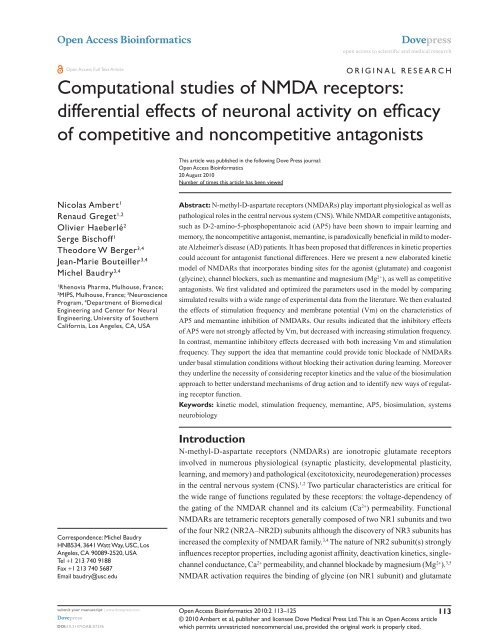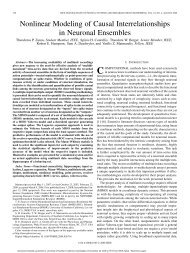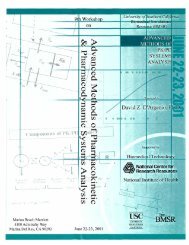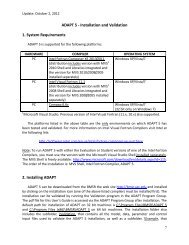Computational studies of NMDA receptors: differential effects of ...
Computational studies of NMDA receptors: differential effects of ...
Computational studies of NMDA receptors: differential effects of ...
You also want an ePaper? Increase the reach of your titles
YUMPU automatically turns print PDFs into web optimized ePapers that Google loves.
Dovepresstherefore increasing the occurrence <strong>of</strong> potentially toxicside <strong>effects</strong>. 32,33Influence <strong>of</strong> stimulation frequencyand membrane potential on the <strong>effects</strong><strong>of</strong> noncompetitive antagonistsToday, the noncompetitive antagonist, memantine, is one<strong>of</strong> the most commonly prescribed drugs to treat mildto moderate AD patients. Regarding the critical role <strong>of</strong><strong>NMDA</strong>Rs in learning and memory, the use <strong>of</strong> an antagonist<strong>of</strong> <strong>NMDA</strong>Rs to treat this disease characterized by majorimpairment <strong>of</strong> cognitive functions has been the subject <strong>of</strong>many debates. In particular, the differences between a rapid<strong>of</strong>f-rate antagonist, such as memantine, and a slow <strong>of</strong>f-rateone, such as MK-801, have been discussed to account forthe different patterns <strong>of</strong> inhibition produced by these twotypes <strong>of</strong> antagonists. 34 Our results showed that the inhibitorypotency <strong>of</strong> memantine is markedly dependent on bothmembrane potential and stimulation frequency. This supportsthe notion that memantine provides a tonic blockade<strong>of</strong> <strong>NMDA</strong>Rs under basal conditions, which could accountfor its neuroprotective properties. In contrast, the inhibitorypotency is decreased by more than 100 fold under conditions<strong>of</strong> membrane depolarization and high frequency stimulation<strong>of</strong> <strong>NMDA</strong>Rs, conditions that are presumably associated withlearning new information. 34 This mechanism would thereforeexplain why memantine does not impair learning andmemory. This hypothesis was previously advanced by severallaboratories and our results certainly provide quantitativeevidence for its validity. 34,35Usefulness <strong>of</strong> a detailed model<strong>of</strong> <strong>NMDA</strong>RsMore generally, the detailed kinetic model <strong>of</strong> <strong>NMDA</strong>Rswe have developed could provide a very useful tool todetermine the influence <strong>of</strong> a variety <strong>of</strong> compounds actingon various elements <strong>of</strong> the model on <strong>NMDA</strong>R functionand under a variety <strong>of</strong> experimental conditions. While thechoice <strong>of</strong> some <strong>of</strong> the parameters was guided by the abilityto reproduce a large set <strong>of</strong> experimental data, we did notnecessarily evaluate the whole space <strong>of</strong> parameter values.A relatively similar model <strong>of</strong> <strong>NMDA</strong>Rs has been used toaddress the question <strong>of</strong> the potential <strong>differential</strong> roles <strong>of</strong>NR2- and NR2B-containing <strong>receptors</strong> in LTP induction, 8while a different kinetic model was used to explore therole <strong>of</strong> <strong>NMDA</strong>Rs in spike timing-dependent plasticity. 36Furthermore, additional binding sites could be easily<strong>NMDA</strong> receptor computational modelimplemented in order to study the <strong>effects</strong> <strong>of</strong> other regulators<strong>of</strong> the <strong>receptors</strong>, such as spermine, Zn 2+ , or other allostericmodulators. In addition, the model we developed could beused to determine the influence <strong>of</strong> various kinetic parameters(rates <strong>of</strong> activation, deactivation, or desensitization)on <strong>NMDA</strong>R function using a wide range <strong>of</strong> stimulation. Inparticular, it is clear that the rate <strong>of</strong> deactivation (J18, k <strong>of</strong>f)appears to have a significant effect on <strong>NMDA</strong>R function.Another important conclusion <strong>of</strong> our simulation is theneed to take into account the dynamic aspects <strong>of</strong> receptorproperties and <strong>of</strong> neuronal activity to understand the mode<strong>of</strong> action <strong>of</strong> compounds acting at different sites <strong>of</strong> the<strong>receptors</strong>. Specifically, while it is clear that a competitiveantagonist might provide a powerful blockade <strong>of</strong> receptorunder equilibrium conditions, it might lose its potency underconditions <strong>of</strong> high frequency stimulation, which might bepresent under pathological conditions. Ultimately, the modelwe have developed could be used to identify new targets toincrease or decrease <strong>NMDA</strong>R function.AcknowledgmentsSupported by grants R01NS057128-01A2 from NINDS toMB, and P41 EB001978-24 from NIBIB to TWB; Rhenoviaobtained financing by the French Ministry <strong>of</strong> Research,OSEO, the Region Alsace, the European Community,Altran-Est, the French National Agency <strong>of</strong> Research andTechnology (ANRT) with a Cifre grant (RG), Alsace BusinessAngels, and SODIV. The authors wish to thanks Dr AF Kellerfor helpful discussions.DisclosureMB, TB, and JMB have a conflict <strong>of</strong> interest.The University <strong>of</strong> Southern California holds an equityinterest in Rhenovia Pharma and has also received licensingincome from Rhenovia Pharma. For more information, visitwww.rhenovia.com.References1. Berger TW. Long-term potentiation <strong>of</strong> hippocampal synaptic transmissionaffects rate <strong>of</strong> behavioral learning. Science. 1984;224:627–630.2. Lynch G, Baudry M. The biochemistry <strong>of</strong> memory: a new and specifichypothesis. Science. 1984;224:1057–1063.3. Dingledine R, Borges K, Bowie D, Traynelis SF. The glutamate receptorion channels. Pharmacol Rev. 1999;51:7–61.4. Ciabarra AM, et al. Cloning and characterization <strong>of</strong> chi-1: a developmentallyregulated member <strong>of</strong> a novel class <strong>of</strong> the ionotropic glutamatereceptor family. J Neurosci. 1995;15:6498–6508.5. Cull-Candy SG, Leszkiewicz DN. Role <strong>of</strong> distinct <strong>NMDA</strong> <strong>receptors</strong>ubtypes at central synapses. Sci STKE. 2004;255:re16.6. Kotermanski SE, Johnson JW. Mg 2+ imparts <strong>NMDA</strong> receptor subtypeselectivity to the Alzheimer’s drug memantine. J Neurosci. 2009;29:2774–2779.Open Access Bioinformatics 2010:2submit your manuscript | www.dovepress.com123Dovepress
Ambert et alDovepress7. Morris RG. Synaptic plasticity and learning: selective impairment <strong>of</strong>learning rats and blockade <strong>of</strong> long-term potentiation in vivo by theN-methyl-D-aspartate receptor antagonist AP5. J Neurosci. 1989;9:3040–3057.8. Santucci DM, Raghavachari S. The <strong>effects</strong> <strong>of</strong> NR2 subunit- dependent<strong>NMDA</strong> receptor kinetics on synaptic transmission and CaMKIIactivation. PLoS Comput Biol. 2008;4:e1000208.9. Danysz W, Parsons CG. The <strong>NMDA</strong> receptor antagonist memantine as asymptomatological and neuroprotective treatment for Alzheimer’s disease:preclinical evidence. Int J Geriatr Psychiatry. 2003;18:S23–S32.10. Rammes G, Danysz W, Parsons CG. Pharmacodynamics <strong>of</strong> memantine:an update. Curr Neuropharmacol. 2008;6:55–78.11. Schorge S, Elenes S, Colquhoun D. Maximum likelihood fitting <strong>of</strong> singlechannel <strong>NMDA</strong> activity with a mechanism composed <strong>of</strong> independentdimers <strong>of</strong> subunits. J Physiol. 2005;569:395–418.12. Liu L, et al. Role <strong>of</strong> <strong>NMDA</strong> receptor subtypes in governing the direction<strong>of</strong> hippocampal synaptic plasticity. Science. 2004;304:1021–1024.13. Bouteiller JM, et al. Modeling glutamatergic synapses: insightsinto mechanisms regulating synaptic efficacy. J Integr Neurosci.2008;7:185–197.14. Hucka M, et al. The systems biology markup language (SBML):a medium for representation and exchange <strong>of</strong> biochemical networkmodels. Bioinformatics. 2003;19:524–531.15. Jahr CE, Stevens CF. Voltage dependence <strong>of</strong> <strong>NMDA</strong>-activated macroscopicconductances predicted by single-channel kinetics. J Neurosci.1990;10:3178–3182.16. Wyllie DJ, Johnston AR, Lipscombe D, Chen PE. Single-channelanalysis <strong>of</strong> a point mutation <strong>of</strong> a conserved serine residue in the S2ligand-binding domain <strong>of</strong> the NR2A <strong>NMDA</strong> receptor subunit. J Physiol.2006;574:477–489.17. Ascher P, Nowak L. The role <strong>of</strong> divalent cations in the N-methyl-D-aspartate responses <strong>of</strong> mouse central neurones in culture. J Physiol.1988;399:247–266.18. Zhang W, Howe JR, Popescu GK. Distinct gating modes determinethe biphasic relaxation <strong>of</strong> <strong>NMDA</strong> receptor currents. Nat Neurosci.2008;11:1373–1375.19. Frizelle PA, Chen PE, Wyllie DJ. Equilibrium constants for (R)-[(S)-1-(4-bromo-phenyl)-ethylamino]-(2,3-dioxo-1,2,3,4-tetrahydroquinoxalin-5-yl)-methyl]-phosphonic acid (NVP-AAM077) acting at recombinantNR1/NR2A and NR1/NR2B N-methyl-D-aspartate <strong>receptors</strong>:Implications for <strong>studies</strong> <strong>of</strong> synaptic transmission. Mol Pharmacol.2006;70:1022–1032.20. Anson LC, Schoepfer R, Colquhoun D, Wyllie DJ. Single-channelanalysis <strong>of</strong> an <strong>NMDA</strong> receptor possessing a mutation in the region <strong>of</strong>the glutamate binding site. J Physiol. 2000;527 Pt 2:225–237.21. Benveniste M, Mienville JM, Sernagor E, Mayer ML. Concentration-jumpexperiments with <strong>NMDA</strong> antagonists in mouse cultured hippocampalneurons. J Neurophysiol. 1990;63:1373–1384.22. Popescu G, Robert A, Howe JR, Auerbach A. Reaction mechanismdetermines <strong>NMDA</strong> receptor response to repetitive stimulation. Nature.2004;430:790–793.23. Fayyazuddin A, Villarroel A, Le G<strong>of</strong>f A, Lerma J, Neyton J. Fourresidues <strong>of</strong> the extracellular N-terminal domain <strong>of</strong> the NR2A subunitcontrol high-affinity Zn 2+ binding to <strong>NMDA</strong> <strong>receptors</strong>. Neuron.2000;25:683–694.24. Gielen M, et al. Structural rearrangements <strong>of</strong> NR1/NR2A <strong>NMDA</strong><strong>receptors</strong> during allosteric inhibition. Neuron. 2008;57:80–93.25. Madry C, Mesic I, Betz H, Laube B. The N-terminal domains <strong>of</strong>both NR1 and NR2 subunits determine allosteric Zn 2+ inhibition andglycine affinity <strong>of</strong> N-methyl-D-aspartate <strong>receptors</strong>. Mol Pharmacol.2007;72:1535–1544.26. Erreger K, Traynelis SF. Allosteric interaction between zinc and glutamatebinding domains on NR2A causes desensitization <strong>of</strong> <strong>NMDA</strong><strong>receptors</strong>. J Physiol. 2005;569:381–393.27. Kloda A, Clements JD, Lewis RJ, Adams DJ. Adenosine triphosphateacts as both a competitive antagonist and a positive allosteric modulatorat recombinant N-methyl-D-aspartate <strong>receptors</strong>. Mol Pharmacol.2004;65:1386–1396.28. Collingridge G. Synaptic plasticity. The role <strong>of</strong> <strong>NMDA</strong> <strong>receptors</strong> inlearning and memory. Nature. 1987;330:604–605.29. Grover LM, Kim E, Cooke JD, Holmes WR. LTP in hippocampal areaCA1 is induced by burst stimulation over a broad frequency rangecentered around delta. Learn Mem. 2009;16:69–81.30. Farin A, Marshall LF. Lessons from epidemiologic <strong>studies</strong> in clinical trials<strong>of</strong> traumatic brain injury. Acta Neurochir. 2004;Suppl 89:101–107.31. Benveniste H, Drejer J, Schousboe A, Diemer NH. Elevation <strong>of</strong> theextracellular concentrations <strong>of</strong> glutamate and aspartate in rat hippocampusduring transient cerebral ischemia monitored by intracerebralmicrodialysis. J Neurochem. 1984;43:1369–1374.32. Ikonomidou C, Turski L. Why did <strong>NMDA</strong> receptor antagonists failclinical trials for stroke and traumatic brain injury? Lancet Neurol.2002;1:383–386.33. Davis SM, et al. Selfotel in acute ischemic stroke : possible neurotoxic<strong>effects</strong> <strong>of</strong> an <strong>NMDA</strong> antagonist. Stroke. 2000;31:347–354.34. Parsons CG, St<strong>of</strong>fler A, Danysz W. Memantine: a <strong>NMDA</strong> receptorantagonist that improves memory by restoration <strong>of</strong> homeostasis in theglutamatergic system – too little activation is bad, too much is evenworse. Neuropharmacology. 2007;53;699–723.35. Lipton SA. Paradigm shift in neuroprotection by <strong>NMDA</strong> receptor blockade:memantine and beyond. Nat Rev Drug Discov. 2006;5:160–170.36. Urakubo H, Honda M, Froemke RC, Kuroda S. Requirement <strong>of</strong> anallosteric kinetics <strong>of</strong> <strong>NMDA</strong> <strong>receptors</strong> for spike timing-dependentplasticity. J Neurosci. 2008;28:3310–3323.37. Harrision NL, Simmonds MA. Quantitative <strong>studies</strong> on some antagonists<strong>of</strong> N-methyl-D-aspartate in slices <strong>of</strong> rat cerebral cortex. Br J Pharmacol.1985;84:381–391.124submit your manuscript | www.dovepress.comDovepressOpen Access Bioinformatics 2010:2
Dovepress<strong>NMDA</strong> receptor computational modelSupplementary materialsR_Glu_Ant_GlyR_2GluGlyJ35GluJ1J9GlyDensensitizedAntR_Glu_AntJ21R_GluR_2Glu_2GlyJ13Open1_MgAntGluJ20AntGluJ0AntGlyJ8GluJ5J11GlyJ12State6J14MgJ40R_2AntJ25R_AntJ19RR_Glu_Ant_2GlyJ35R_Glu_GlyR_2Glu_2GlyState4J18Open1VmJ26J23J2GlyJ10GluJ7J15State5J17J39GlyR_2Ant_GlyAntJ24GlyR_Ant_2GlyAntJ22GlyR_GlyGluR_Glu_2GlyJ34R_Glu_Ant_2GlyJ16MemOpen1_MemJ31J3GluJ6AntOpen2GlyJ27GlyJ28GluR_Glu_Ant_GlyGlyR_2GlyJ33R_Ant_2GlyMgJ41J38MemR_2Ant_2GlyAntJ29R_Ant_2GlyGluJ30J32R_Glu_Ant_2GlyGlyAntOpen2_MgVmOpen2_MemSupplementary figure 1 Kinetic scheme <strong>of</strong> the <strong>NMDA</strong> receptor with competitive and noncompetitive antagonists. Representation <strong>of</strong> the kinetic schema <strong>of</strong> the <strong>NMDA</strong>Rfrom Schorge et al 11 with a competitive agonist, such as AP5 (orange boxes) and a noncompetitive antagonist, such as memantine (grey boxes) (adapted from Kotermanskiet al 6 ) implemented in a graphical user interface-based design tool for visual model development.Notes: Each state binding a glutamate molecule in this new kinetic scheme also binds AP5 with association rate constant (k onA) <strong>of</strong> 0.38 mM -1 .ms -1 and dissociation rate constant(k <strong>of</strong>fA) <strong>of</strong> 0.02 ms −1 for reactions labeled J19, J21, J22, J24, J25, J29, J33, J34, and J35. We assumed that association rate constants for glycine and glutamate were not affected byAP5. Memantine binds to states Open1 and Open2, which are now voltage-dependent (state Vm) to generate states Open1_Mem and Open2_Mem, respectively. Mg 2+ bindsto states Open1 and Open2 to generate states Open1_Mg and Open2_Mg, respectively. The dissociation rate constant for memantine was set at 4.4e −4 ms −1 (k <strong>of</strong>fMem) andassociation (k onMem) was calculated as the ratio <strong>of</strong> k <strong>of</strong>fMemand Kd with Kd = (0.8e −3 * exp(Vm + 66)/31.6). Magnesium (Mg 2+ ): association rate constant (k onMg) was calculated withthe following equation: (426 * exp[Vm/55])/(1 + 91.3 * exp[Vm/21.0]) and dissociation rate constant (k <strong>of</strong>fMg) with 61.8e −3 * exp(-Vm/50.0) + 4280e −3 * exp(Vm/52.7), accordingto Kotermanski et al. 6 <strong>NMDA</strong>-mediated current was calculated as I <strong>NMDA</strong>= nb <strong>NMDA</strong>× I 0.0nn0.050.10.15Open probability0.20.250.30.350.40.450.50 0.02 0.04 0.06 0.08 0.1 0.12Time (S)Supplementary figure 2 Paired pulse facilitation <strong>of</strong> <strong>NMDA</strong>R response.Notes: Open probability <strong>of</strong> <strong>NMDA</strong>R in response to a single or a paired pulse application <strong>of</strong> 1 mM glutamate for 1 ms, with an interval between pulses <strong>of</strong> 10 ms, in the presence<strong>of</strong> 100 µM glycine and in absence <strong>of</strong> Mg 2+ . The ration <strong>of</strong> peak open probabilities between the second and the first pulse was 1.32.Open Access BioinformaticsPublish your work in this journalOpen Access Bioinformatics is an international, peer-reviewed, openaccess journal publishing original research, reports, reviews andcommentaries on all areas <strong>of</strong> bioinformatics. The manuscript managementsystem is completely online and includes a very quick and fairDovepresspeer-review system. Visit http://www.dovepress.com/testimonials.phpto read real quotes from published authors.Submit your manuscript here: http://www.dovepress.com/open-access-bioinformatics-journalOpen Access Bioinformatics 2010:2submit your manuscript | www.dovepress.comDovepress125










